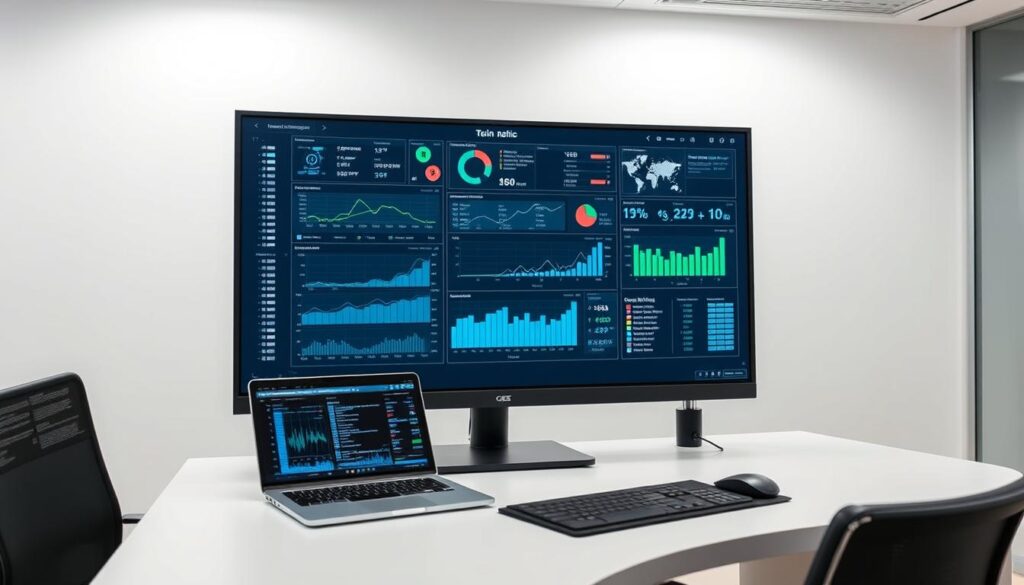You rely on stable systems, secure data, and steady communications to run your business. At Boom Logic, our local team in Los Angeles, Pasadena, and Burbank helps you offload daily IT work so your staff can focus core tasks.
Our approach gives you 24/7 monitoring, proactive security, cloud management, and RMM for infrastructure. That means fewer disruptions, faster issue resolution, and clearer reporting on performance and costs.
Working with msps or managed service providers adds capacity without more headcount. You get access to expertise and documented processes that improve operations and reduce risk.
For companies in the region, local knowledge of connectivity and vendors matters. We align technology to business outcomes so your company gains reliable solutions and better visibility into system health.
Key Takeaways
- Outsource routine IT to gain continuous support and lower operational friction.
- Proactive monitoring and managed security reduce downtime and risk.
- Cloud and infrastructure management boost performance and control costs.
- Working with providers gives your team access to specialized expertise.
- Local presence in Los Angeles, Pasadena, and Burbank improves vendor and facility alignment.
How we define it
Clear roles, measurable targets, and proactive care form the backbone of our approach. At Boom Logic, you get an outsourced IT partnership built around SLAs that set uptime, response, and reporting expectations.
We focus on proactive management to spot issues before users see them. Continuous monitoring, routine maintenance, and timely updates reduce firefighting and simplify planning.

Outsourced IT partnership
You engage with defined scope, responsibilities, and performance metrics so work aligns to your needs. Our team complements your staff without disrupting core operations.
Proactive management focus
Our model uses structured processes for incident handling, change control, and regular reviews. Cadence meetings and transparent reporting keep delivery accountable and open to improvement.
- Predictable subscriptions and continuous improvement cycles.
- Risk management from patching to configuration baselines.
- Scalable support that adjusts as your environment changes.
- Business-aligned insights to prioritize high-value projects.
what is it managed services
Your IT needs steady oversight so systems run smoothly and staff stay productive. At Boom Logic, we deliver outcome-driven support for Los Angeles, Pasadena, and Burbank companies.

Scope and outcomes
Think of this model as defined offerings tied to uptime, security posture, and user experience rather than one-off fixes.
The scope covers systems and infrastructure, cloud tuning, identity and endpoint care, plus backup and recovery. We set measurable targets and link management tasks to KPIs like mean time to resolution, patch compliance, and backup success.
From break fix to MSP
We move you past reactive repair by instituting continuous monitoring and routine maintenance that prevent repeat issues and stabilize performance. Our provider duties include documentation, asset baselines, and lifecycle planning so your team always knows what’s next.
- Fewer incidents and faster resolution times
- Consistent controls across on‑prem and cloud
- Clear reporting grounded in data and trends
The MSP role
Round-the-clock attention keeps critical systems healthy and your team productive. Our approach combines nonstop monitoring with clear escalation so issues get handled fast.

24 7 365 coverage
You receive true 24/7/365 support and monitoring across Los Angeles, Pasadena, and Burbank. That means coverage after hours, weekends, and holidays so users stay productive and downtime is limited.
SLAs and reporting
We define SLAs for response and resolution and tailor them to your business rhythms and risk tolerance. Reporting gives you ticket trends, systems status, backup and patch results, and security findings.
- Standardized playbooks and best practices keep infrastructure baselines consistent.
- Monitoring spans endpoints, servers, network gear, and critical applications.
- Security operations include alert triage, containment guidance, and incident coordination to limit downtime.
- Potential issues are escalated with clear impact statements and options so you can act quickly.
We work with third-party providers where needed, coordinating handoffs and keeping documentation up to date for continuity and compliance.
Core service areas
Core offerings cover monitoring, security, cloud operations, backup, and voice so your tech stays aligned to day-to-day goals.

Remote monitoring (RMM) tracks availability, capacity, and performance across servers, endpoints, and network gear. Automation handles routine fixes and flags anomalies before users notice impact.
Managed security stack
Prevention, detection, and response combine patch cadence, endpoint protection, firewall oversight, and SIEM integration to reduce risk and support compliance.
Cloud setup and ops
We configure cloud accounts, enforce identity controls, and optimize costs. Ongoing operations include right-sizing workloads and tuning applications for reliability.
Backup and recovery
Policy-driven backups use immutable targets where appropriate, with recovery testing to verify data integrity. Disaster plans define RTO/RPO and include periodic exercises.
Communication and VoIP
Design, number porting support, QoS tuning, and call monitoring keep voice and collaboration crisp for your teams.
- Application-aware monitoring ties health to user experience.
- Documentation and knowledge transfer preserve configuration history.
- Continuous refinement prevents configuration drift and keeps operations predictable.
Explore local examples and community work via our Pasadena summary at city projects.
Business benefits
When routine IT work is handled offsite, your company gains bandwidth for strategic moves. Boom Logic helps Los Angeles, Pasadena, and Burbank teams trade maintenance chores for project time.
Access to expertise
You gain broad expertise across networking, cloud, security, and collaboration without hiring for every role. That extends your internal resources and adds depth during turnover or peaks.
Downtime risk reduction
Proactive monitoring and routine maintenance lower downtime risk. Faster detection improves performance across systems and infrastructure, and reduces chance of data loss or extended outages.
Focus on core work
The service model shifts routine operations off your staff, letting you prioritize product, sales, and growth. Standardized processes and clear reporting also make planning more predictable and help manage costs.
- Access to specialized expertise without extra headcount
- Fewer incidents and better system performance
- Predictable operations, stronger security, and clearer ROI
Pricing models explained
Pricing choices shape how your team pays for uptime, security, and access to expertise. Below are common approaches and quick guidance to help you pick the right model for Los Angeles, Pasadena, and Burbank companies.
Per device model
Use this when endpoint and server counts are stable. Charges scale with hardware counts, which makes budgeting straightforward and predictable.
Per user model
This fits environments where each person uses multiple devices. Pricing follows people rather than hardware, so support links directly to users.
Tiered service packs
Bundles group capabilities into clear levels. Tiered packs let you match coverage to business priorities and control costs as needs change.
A la carte picks
Select targeted offerings to fill gaps. A la carte options work well when you keep some functions in-house and outsource specific expertise.
Value, outcome, and consumption based
Value pricing ties fees to business gains, while outcome pricing links pay to defined results and measurable KPIs. Consumption billing charges based on actual use, useful for variable cloud workloads.
- We help you weigh cost drivers like coverage hours, security depth, and reporting cadence.
- Choice depends on company stage, resources, and environment complexity.
- Clear documentation and measurement keep transparency and control.
Limits and pitfalls
Even solid tech stacks can hide gaps that show up during growth or stress. You should set realistic expectations and look for clarity before signing a contract.
Accountability gaps
Unclear SLAs leave you chasing answers. Demand uptime targets, response and resolution times, plus regular reporting so roles stay clear.
Weak IT roadmaps
Short-term fixes don’t replace planning. Insist on lifecycle roadmaps for upgrades, patching, and configuration changes to protect future value.
Track record checks
Past performance predicts fit. Ask for references from similar businesses and request a systems audit to verify competence with your platforms and tools.
- Document shared responsibilities to avoid assumptions about backups and security configurations.
- Review escalation paths, on-call structure, and how findings are turned into priorities.
- Confirm compliance experience for logging, retention, and audits related to your data.
- Consider coverage scalability so seasonal peaks don’t create gaps that raise costs later.
Choosing a provider
Choosing the right partner shapes how technology supports your business goals. Use a simple, repeatable process to compare options and protect future value.
Align to goals
Map outcomes first. Start by tying your business goals to IT outcomes so SLAs track what matters. Assess current systems and list priorities for uptime, applications, and software changes.
Security and compliance
Verify security depth: monitoring, incident response, and compliance-aware processes. Request audits to confirm competence with your stack and to validate handling of sensitive data.
Scalability and coverage
Confirm the provider can scale for cloud migrations, new sites, or user growth. Ensure coverage hours and response targets match peak needs and planned projects.
Right size support
Choose support levels that match your company today and can adapt as you grow. Review documentation standards, reporting cadence, tool integration, and references from similar businesses.
- Map goals to SLAs and outcomes
- Request audits for software and applications
- Validate cloud governance and cost management
- Balance internal resources with provider responsibilities
Our local approach
Local context shapes how we design tech support and project timelines across Southern California. Boom Logic aligns coverage to daily rhythms, vendor access, and building logistics so your team sees fewer surprises.
Los Angeles needs
We account for scale, traffic, and site timing. That means planning onsite visits when access is easiest and scheduling changes to avoid peak commute windows.
Our local vendor ties speed up fixes for connectivity and equipment. We also tune cloud setups for latency-sensitive workloads that many LA teams rely on.
Pasadena and Burbank
Pasadena blends long‑established firms and research groups that demand strong security and compliance controls. In Burbank, media and production workflows need reliable collaboration and safe content handling.
- Aligned coverage windows to match your operations
- Security operations tailored to urban threat profiles
- Compliance-ready processes to simplify audits
- Practical rollouts for voice, networks, and multi-tenant sites
The result: timely, practical solutions that help your business reduce downtime, protect data, and support growth.
Talk to Boom Logic
A focused assessment helps align technology tasks to your business goals. Start with a short discovery so we can map assets, risks, and immediate priorities for your Los Angeles, Pasadena, or Burbank team.
Your next step
We begin with an audit that clarifies scope, SLAs, and reporting tied to outcomes you care about. From there, onboarding documents assets, policies, and integrations to avoid gaps in support.
- If you’re local, we do a short discovery to understand your environment and objectives.
- We align scope, SLAs, and reporting to your priorities for transparency day one.
- Onboarding captures assets and policies so the provider can protect your data and reduce surprises.
- A clear communication plan sets cadence so stakeholders know how we’ll collaborate.
- We propose a right-sized service package that stays flexible as your company grows.
After kickoff, we initiate monitoring, security baselines, and backup validation to stabilize systems quickly. Regular reports show steady improvements you can share with leadership.
Conclusion
Wrapping core technology under one accountable plan reduces surprises and keeps projects moving.
You get proactive monitoring, SLAs, and clear reporting that tie security, cloud, backup, communications, and infrastructure to business outcomes. This approach boosts performance, lowers downtime, and makes costs more predictable.
Align needs, resources, and expertise with the right model to gain resilience and scalable growth. Address potential issues early by defining accountability, validating track records, and checking capacity for change.
When you pair thoughtful management with best practices, compliance-minded workflows, and strong documentation, your company keeps core initiatives moving while technology stays secure, efficient, and ready for what’s next.


